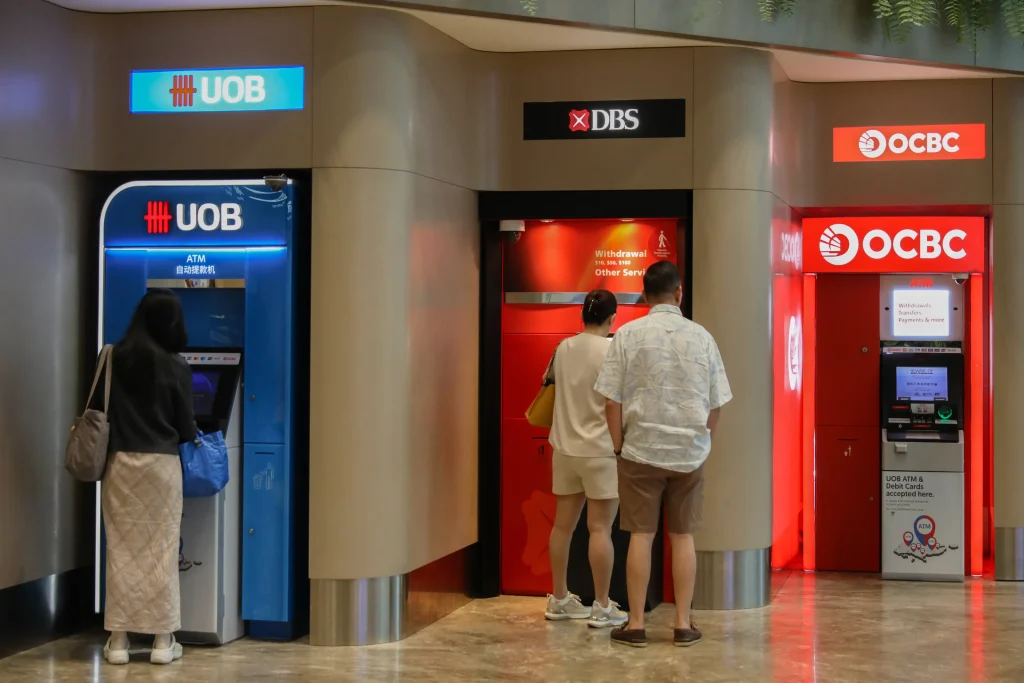[SINGAPORE] Uncertainty from US tariffs loomed large as Singapore’s three local banks reported their first-quarter results over the past week.
The macroeconomic jitters were significant enough for UOB to suspend its earnings guidance for 2025, although DBS and OCBC have kept theirs unchanged for now.
All three banks also set aside additional pre-emptive allowances to strengthen their reserves, even as they stressed that asset quality remains stable.
The decline came amid lower net interest income and a rise in operating expenses.
BT in your inbox

Start and end each day with the latest news stories and analyses delivered straight to your inbox.
UOB reported a net profit of S$1.49 billion, unchanged from the previous year, but fell short of the S$1.54 billion consensus forecast.
In terms of reserves, DBS set aside S$205 million in general allowances during the quarter, bringing total allowances to S$325 million – 56 per cent higher than the previous quarter.
OCBC’s allowances rose 2 per cent on-quarter to S$212 million, led by S$118 million in pre-emptive allowances for non-impaired assets.
UOB increased its total allowances to S$290 million, up from S$212 million in the previous quarter, as it reinforced provision coverage.
Knock-on effects
The banks stressed that the greater concern lies not in the direct impact of tariffs, but in the secondary effects – particularly a possible dip in consumer confidence that could lead to a broader economic slowdown.
UOB deputy chairman and chief executive officer Wee Ee Cheong said his bank was not “overly alarmed” about the direct impact, as trade accounts for only about 10 per cent of UOB’s portfolio, with 80 per cent of that being intra-Asia.
While UOB’s credit cost rose 10 basis points (bps) on-quarter to 35 bps, it remains well below the 57 bps seen during the Covid-19 pandemic, he added at the bank’s May 7 earnings call.
At DBS, CEO Tan Su Shan said stress tests showed that the bank would not be “so badly affected” by direct tariff exposure.
“The good news is our direct exposure between China and the US, in terms of flows to the US, is pretty muted (and) very limited, so I don’t see a lot of impact there,” she said during a May 8 briefing.
OCBC group CEO Helen Wong noted at a May 9 earnings call that only 3 per cent of the bank’s loan book is expected to be directly affected by current tariffs.
She identified the impacted industries as manufacturing, goods production, international transport, storage, raw materials and commodities.
Outlook ahead
Looking ahead, analysts said the trajectory of the tariff situation will be a key swing factor for the banks’ performance in the coming quarters.
CGS International analysts Tay Wee Kuang and Lim Siew Khee, in a May 9 report, upgraded DBS to “add” from “hold” with a S$47.90 target price, citing “sustainable” returns driven by core earnings growth and capital return initiatives.
They pointed to earnings contributions from wealth management, loan-related fees and a “healthy pipeline” of non-trade corporate loans.
Maybank analyst Thilan Wickramasinghe kept his “hold” rating, noting the lender’s “safe haven” appeal and commitment to capital returns.
However, he flagged limited potential for earnings upgrades, given “poor macro visibility”.
On UOB, the CGS International analysts said no major revisions were expected to its now-paused FY2025 guidance, with the bank on track to meet its goals on total income and double-digit fee income growth.
They added that Asean and Greater China – which make up 85 per cent of UOB’s loan book – could continue supporting growth through regional trade flows.
Still, DBS Research Group analyst Lim Rui Wen warned of a possible “sequential impact” from a worsening trade war, as 82 per cent of UOB’s group profit before tax comes from Asean.
For OCBC, Jefferies analysts Sam Wong, Chen Shujin and Joanna Cheah noted the bank posted the sharpest net interest margin (NIM) decline among the three lenders in Q1, leaving “not as much room” to meet its full-year 2 per cent guidance.
OCBC’s NIM fell 23 bps year on year to 2.04 per cent. UOB’s Q1 NIM came in at 2 per cent, down slightly from 2.02 per cent a year earlier, while DBS reported a NIM of 2.12 per cent, down from 2.14 per cent previously.
OCBC’s 2 per cent guidance NIM should “drive (a) low-single digits consensus earnings downgrade”, said Citi analyst Tan Yong Hong on May 9.
“On the flipside, asset quality continues to be robust,” Tan said, citing “strong” growth in assets under management for the lender’s wealth business.


